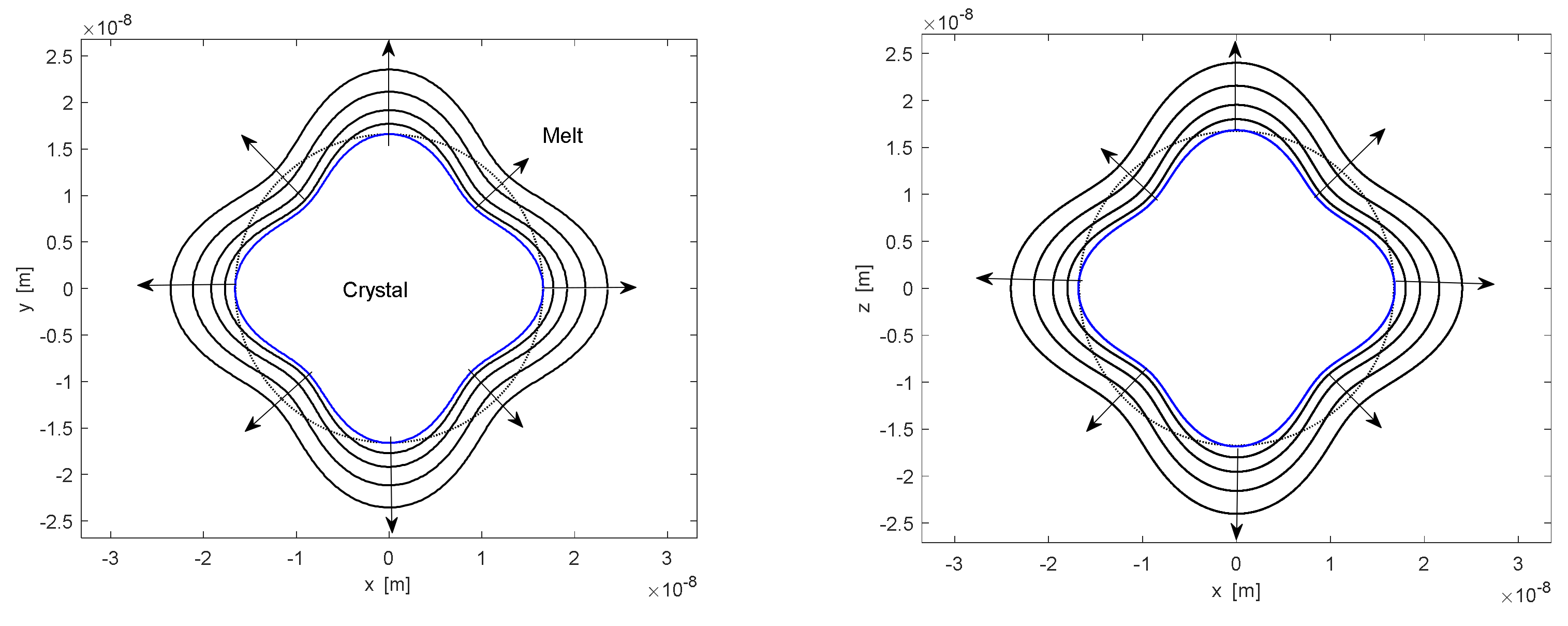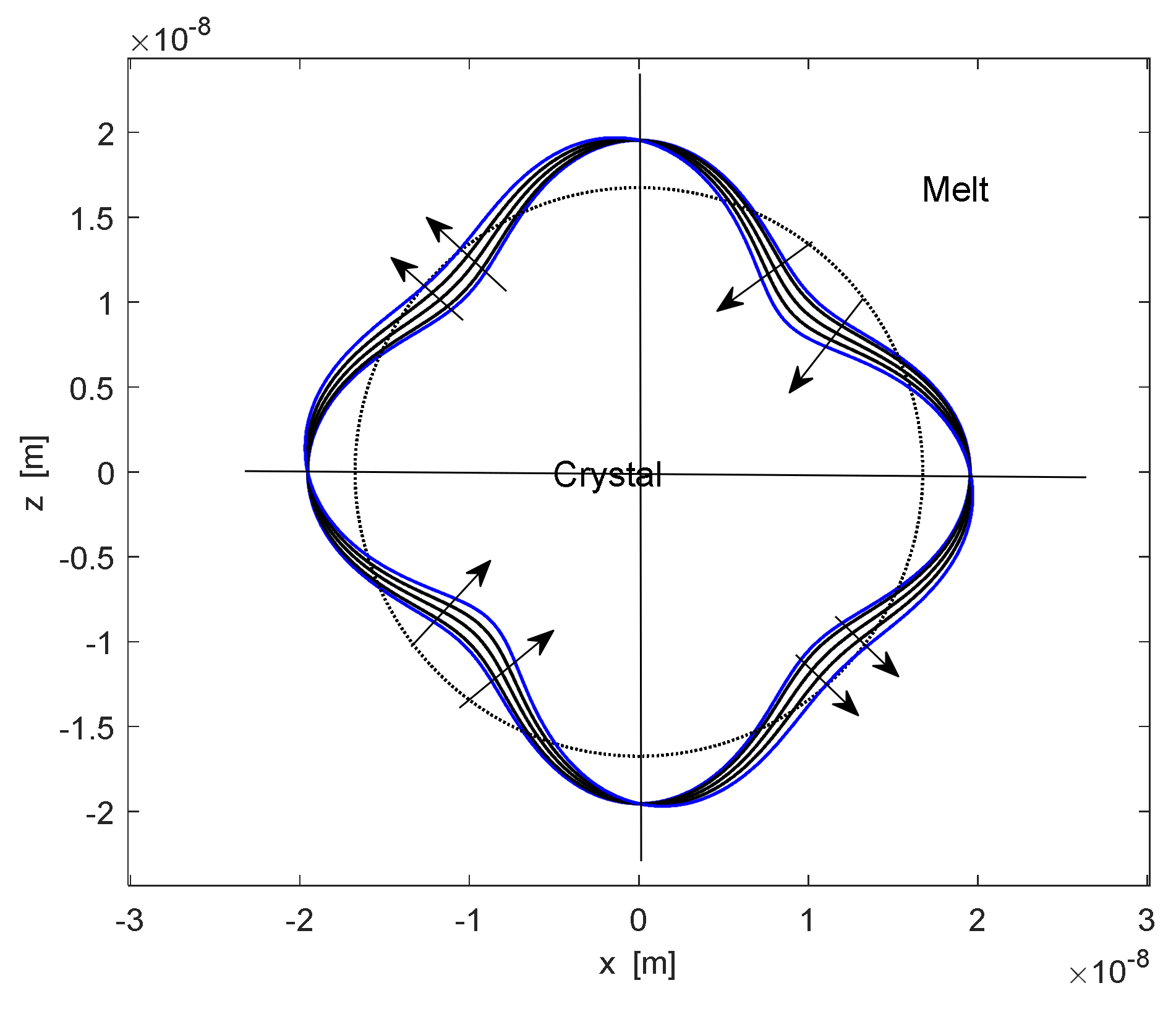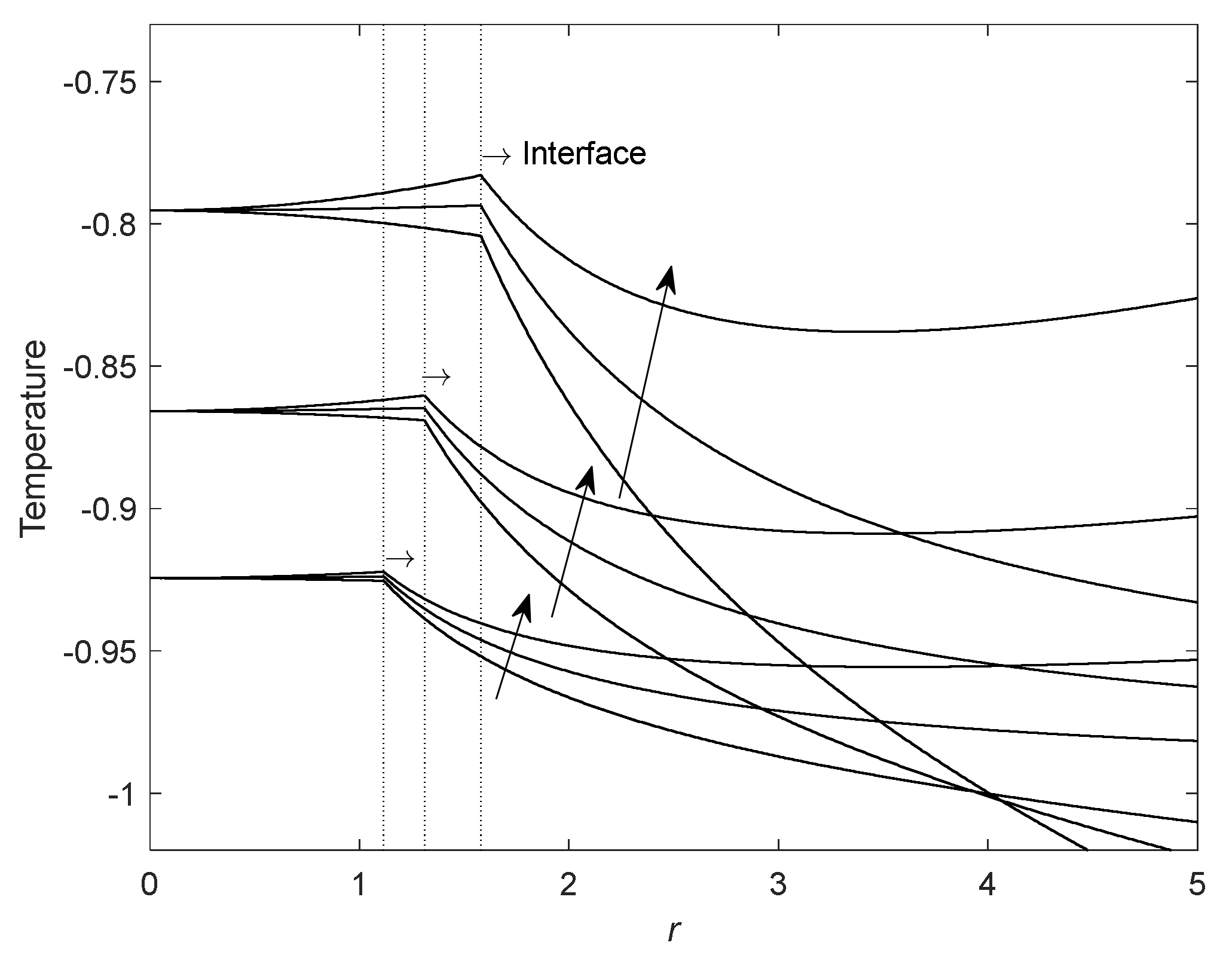2. The Mathematical Model
In the convective undercooled melt, as the temperature decreases below the liquidus, a great amount of crystalline nuclei with different sizes of nearly micro or nano scales forms. The nuclei are nucleating or growing simultaneously in the metastable molten melt. It is assumed that the melt is undercooled to a temperature
(
is the melting equilibrium temperature of pure substance, the melt undercooling is defined as
), and the convection in the melt is driven by an external forced flow. Experiments [
10,
11] have demonstrated that under the influence of the forced flow, these nuclei deform or even split into smaller particles, in which the shear effect of the forced flow plays a key role in the formation of second phase nanoparticles. We focus on the morphological evolution of a particle with initial radius
. For simplicity, the shear effect of the convection velocity
is driven by the expression
where
,
,
and
are the unit vectors of the Cartesian coordinate frame in the Cartesian coordinate system
, respectively, the velocity gradient components
and
are constant velocity gradients.
is the shear rate.
Let
and
respectively denote the velocity and reduced pressure in the liquid phase,
and
respectively denote the temperatures in the liquid phase and solid phase. The interface of the particle is expressed as
in the spherical coordinate system, where
is the time. The continuity equation, Navier–Stokes equations, are:
where
is the Laplace operator,
is the gradient operator,
is the reduced pressure,
is dynamic viscosity of melt, and
is density of melt. The density of solid and liquid phases is assumed to be equal.
The temperature field governing equations of liquid phase and solid phase are expressed as:
where
and
are the thermal diffusion coefficients of liquid phase and solid phase, respectively.
The corresponding interface conditions are the total mass conservation and tangential non slip of the interface
where
and
are the unit normal vector and unit tangent vector of the interface, respectively.
The interface temperature is controlled by the Gibbs–Thomson condition and energy conservation condition at the interface, i.e.,
where
is the moving velocity of the interface,
is the average curvature of the interface,
is the latent heat per unit volume,
is the isotropic surface free energy,
is the interface kinetics coefficient,
is the anisotropy parameter of interface kinetics,
and
are the heat conduction coefficients in the liquid phase and solid phase, respectively.
The above solidification system in Equations (1)–(8) constitutes a free boundary problem for the shape of the crystal–melt interface, and hence for the evolution morphology of the particle.
For the asymptotic analysis, the dimensionless variables are defined by scaling velocity with the characteristic velocity of the crystal–melt interface
, here
is the latent heat per unit volume, the length with the initial radius
, the time with
, the reduced pressure with
, the temperature with
. With the nondimensionalization transformation:
Equations (1)–(4) are transferred into the dimensionless governing equations:
where
is the relative undercooling parameter,
, is the specific heat in the liquid phase, is the density in the liquid phase, and are the thermal diffusivities in the liquid and solid phases, respectively.
The crystal–melt interface conditions (5)–(8) are transferred into the dimensionless interface conditions:
where
the surface energy parameter,
,
,
and
is the value of surface normal in the
i-direction (
),
is the anisotropy strength parameter.
The far-field conditions are:
where
and
are dimensionless velocity gradients,
,
.
is the dimensionless shear rate.
Finally, the initial condition for the interface is that, at time
,
For the sake of simplicity, it is assumed that the densities of the liquid and solid phases are equal, and the buoyancy effects are neglected. The separation or split into two particles or the interaction between particles does not involve them.
3. Asymptotic Solution and Analysis
The quantity
is typically several hundred degrees K. For example, for Fe,
J m
−3,
J kg
−1 K
−1,
kg m
−3,
K; for Cu,
J m
−3,
J kg
−1 K
−1,
kg m
−3,
K. In a practical solidification system, the relative undercooling parameter
is small,
. We take
as a small parameter and seek the asymptotic solution for the free boundary problem for the shape of the crystal–melt interface in Equations (10)–(20). The anisotropic interface kinetics is assumed to be of the same order of magnitude to the small parameter,
,
. We seek the following asymptotic solution for the growth system of the particle
where each order approximation is further expanded into a series of spherical harmonics. The interface curvature is expanded into:
Substituting (21) together with (22) into Equations (10)–(20), we derive the equations and boundary conditions for each order approximation. The leading order approximations for the flow field and the temperature fields satisfy the equations:
which are subject to the interface conditions: at the interface,
The far-field condition is, as
,
The initial condition for the interface is, at time
,
For the flow field, when it is superimposed addictively, the linear shear flow, the flow field throughout the melt, is modified by the additional fluid velocities. After carrying out the differentiation algebra, we have the leading order approximations
and
in the rectangular coordinates
The solution of Equation (24) which obeys the conditions (26)–(31) is
where
is the implicit solution of the ordinary differential equation that satisfies the initial condition (31)
From Equation (34), as
,
, the particle decays, whereas as
,
, the particle grows. Setting
yields a critical value of the particle
. Returning to the dimensional quantity of the critical value,
, we obtain the critical nucleation radius of the particle
as:
The first order approximations for the temperature fields satisfy the equations:
which are subject to the interface conditions at the interface,
where
and
is the associated Legendre polynomial of degree
and order
.
The initial condition for the interface is, at time
,
The solution of Equation (35) which obeys the conditions (36)–(39) is:
where
From the interface condition (38), it follows that satisfy the following ordinary differential equations, respectively.
For the mode
,
where
From the initial condition (39), it follows that
. Then, the solutions of Equation (40) are solved, respectively, as follows,
in which,
Consequently, we have obtained the asymptotic solution of the particle growth,
It can be easily testified that the above solution in (45) does not satisfy the initial conditions for the temperature fields. The cause is that the assumption that
. In order to solve the early-time behavior, we introduce the time fast variable,
, and seek the inner solution in the sense of time. By matching the inner solution with the above solution, we obtain the solutions which obey the initial conditions for the temperature fields.
where
is the complementary error function,
, and
in which
is the initial temperature in the solid phase at time
. Moreover, it is seen that the above asymptotic solution in (45) does not satisfy the vanishing condition in the far field region
as
and then is only valid near the particle. In the far field region, we introduce the slow variable,
, where
. By using the multiple scales expansion method we find the asymptotic solution that obeys the diminishing condition in the far field. Finally, we have obtained the uniformly valid asymptotic solution in the whole melt region in (21). Because the phase transformation occurs mainly near the interface, we use the asymptotic solution in the whole melt region in (45), in which the interface shape is expressed as:
With the analytical solution (45), we show the interface morphology of the particle under the influence of the shear flow. We used the following physical parameters of the Cu–Fe alloy with face-centred cubic (f.c.c) structures and analyze the interface morphology of the particle under the influence of anisotropic interface kinetics and the shear effect of the flow.
The physical parameters of the Cu–Fe alloy: K (Fe), J s−1m−1 K−1 (Cu), J s−1m−1 K−1 (Fe), J kg−1 K−1 (Cu), J kg−1 K−1 (Fe), J m−1 (Fe), J m−3 (Fe), kg m−3 (Cu), kg m−3 (Fe).
Figure 1,
Figure 2 and
Figure 3 show the cross-sectional curves of the interface morphology of a particle growing in an undercooled melt under the influence of anisotropic interface kinetics.
Figure 1 shows the cross section curves of the interface morphologies of a particle under the influence of anisotropic interface kinetics at different times during initial crystal growth after nucleation. It is seen that under the influence of anisotropic interface kinetics, during the initial growth times from
to
, some part of the interface of the particle in the <110> growth directions decays inward. However, when the inward decay proceeds up to a certain distance at a time
, the part of the interface of the particle in the <110> growth directions ceases to grow. During the initial growth process, the inward decay of the part of the interface induced by the anisotropic interface kinetics causes the smaller inner radius, which is less than the critical nucleation radius
. The local inward growth and outward growth of the particle deforms the interface of the spherical crystal and forms the remarkable ear-like interface shape with some concave parts and other convex parts. The particle with a smaller inner radius than the critical nucleation radius
tends to be locally re-melted or broken.
Figure 2 shows the cross-sectional curves of the interface morphology of the particle under the influence of anisotropic interface kinetics at different times after the initial inward growth of some parts of the interface. When the inward decay proceeds up to a certain distance from the time
, the part of the interface of the particle in the <110> growth directions begins to grow outward. During the initial growth process, the inward decay of the part of the interface induced by the anisotropic interface kinetics causes the smaller inner radius, which is less than the critical nucleation radius
. The local inward and outward growth of the particle deforms the interface of the particle and forms the remarkable ear-like interface. According to the classical nucleation theory, the particle with a smaller inner radius than the critical nucleation radius
tends to be locally re-melted or broken. The inward distance induced by the anisotropic interface kinetics is defined as ‘the melting depth’.
Figure 3 shows that under the influence of the shear flow, the interface of the particle with an ear-like shape is deformed. As the shear rate of the flow increases, the interface of the particle with an ear-like shape is distorted. It implies that the shear effect of the flow aggravates the local melting tendency, which is caused by the smaller inner radius than the critical nucleation radius
, leading to the splitting of the distorted particle during the initial crystal growth to form more fine particles.
Figure 4 shows the variations of the temperature near the interface along different growth directions under the shear effect of the forced flow at different times. It is seen that when the shear flow is exerted on the Oxz plane, the shear flow around the particle increases the temperature gradient along the direction viewed from the polar angle and accelerates the growth of some parts of the interface near
but depresses the growth of other parts of the interface near
. With the growth of the particle (the interface where the arrows point is moving right), the interface of the particle is distorted. Because the inward growth of the interface in the initial stage of crystal growth induced by the anisotropic interface kinetics leads to a smaller inner radius than the critical nucleation radius of the particle, the interface of the particle splits into several smaller crystals in the initial stage of crystal growth.
With the resulting theoretical result, we calculate the microstructure formation of the second phase nanoparticles in a centrifugal casting experiment of as-cast Cu–Fe–Co alloys [
11,
16,
23]. The relevant physical parameters are that: the solidification equilibrium temperature of Fe
K, the latent heat per unit volume of Fe
J m
−3, the specific heat of Fe
J kg
−1 K
−1, the density of Fe
kg m
−3, the surface tension of Fe is
J m
−2, the mole mass fraction of Fe
kg mol
−1, the sound velocity
m s
−1, the gas constant
J kg
−1 K
−1, the kinetic coefficient of Fe:
m s
−1 K
−1 (calculated from
), the anisotropy parameter of interface kinetics
; the solidification equilibrium temperature of Cu is taken as
K. From the heat preservation to the end of solidification, the undercooling near the surface of Fe particles in the matrix of the Cu alloy is in the range of 110~375 K, the relatively undercooling parameter
is in the range of 0.20~0.58, the critical radius for nucleation
is in the range of 0.33~0.85 nm. According to our theoretical result, the nanoparticles formed in the Cu–Fe–Co alloy melt are of the same order of magnitude as the critical radius for nucleation. Because the anisotropy of interface kinetics induces the melting depth of the nuclei formed after nucleation, the nuclei have radii less than the critical radius of nucleation
and then tend to split. Under the shear effect of the forced flow, the nuclei are deformed and distorted. As a result, the interface of the particle splits or is broken into several more fine particles in the initial stage of growth after nucleation. The more fine particles repeat the same process to form the particles with nano scales. We should understand that even if one nucleus has split into several smaller particles in the melt, it is hard to judge whether these smaller particles have just split from this particle. By contrast, it is seen that if the shear flow is not exerted in the melt, the dispersed iron nano particles second phase and nano grains is difficult to obtain in the Cu–Fe–Co alloy matrix [
11,
23].









